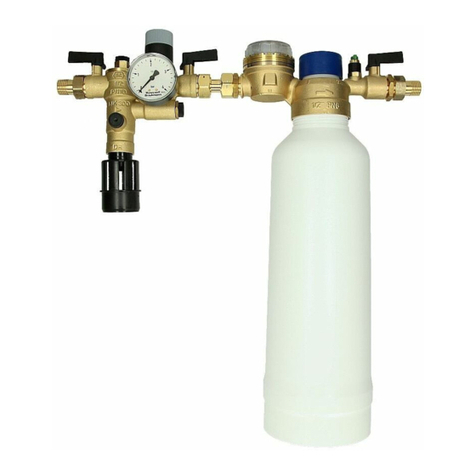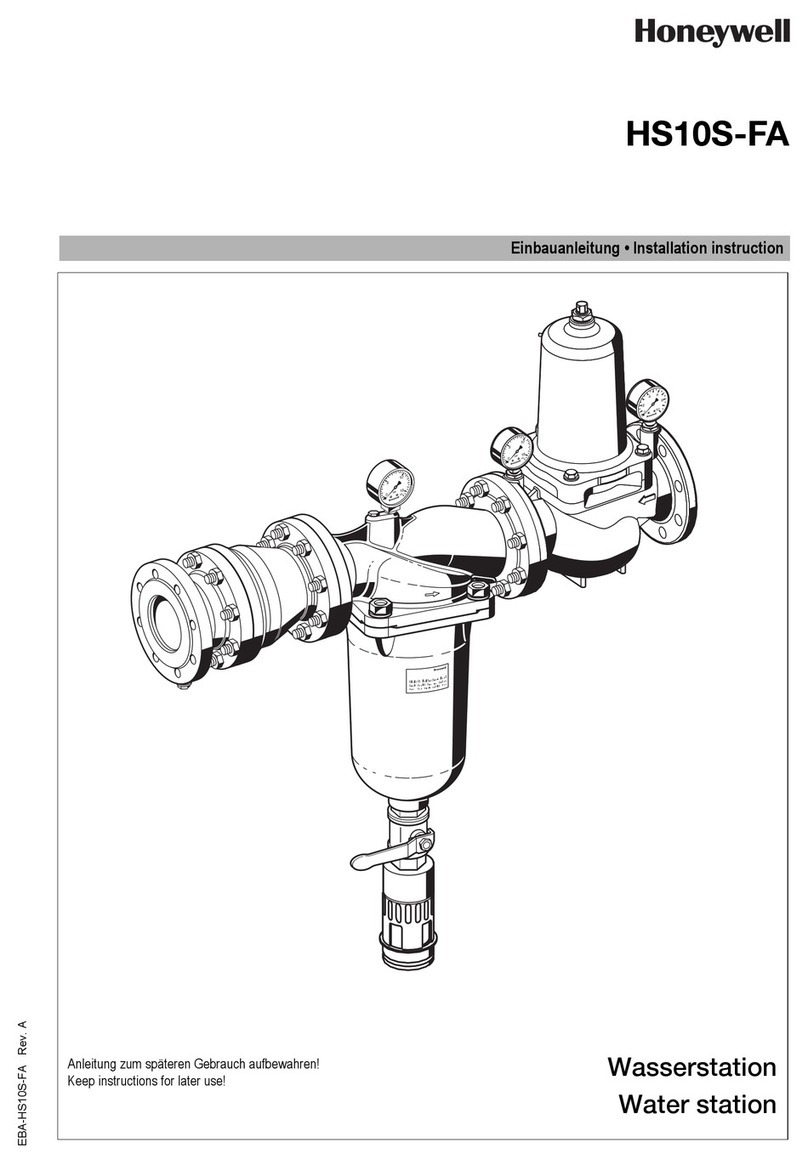
Honeywell GmbH 4 MU1H-1231GE23 R1106
D
8. Instandhaltung
8.1 Inspektion
8.1.1 Funktion Ablassventil
1. GEKA-Kupplung und Schlauch demontieren
2. Absperrventil mit Dichtung ausgangsseitig
montieren und schließen
3. Verschlussstopfen entfernen
4. Kugelhähne mit Dichtung montieren und schließen
5. Eingangsseitiges Absperrventil öffnen
6. Geeignetes Prüfgerät mit Entlastungsventilen
anschließen
7. Kugelhähne Vordruckkammer und Mitteldruck-
kammer öffnen
8. Eingangsseitiges Absperrventil schließen
9. Entlastungsventil am Prüfgerät langsam öffnen
o Druck in Vordruckkammer wird abgebaut
10.Stellung Entlastungsventil beibehalten und Diffe-
renzdruck, bei dem etwa ein Tropfen pro Sekunde
aus Ablassöffnung austritt, als Öffnungsdruck
Ablassventil notieren.
11.Kugelhähne schließen
12.Prüfgerät demontieren
13.Ausgangsseitiges Absperrventil öffnen
14.Absperrventil demontieren
15.Kugelhähne demontieren
16.Verschlussstopfen einschrauben
8.1.2 Funktion ausgangsseitiger Rückflussverhin-
derer
1. GEKA-Kupplung und Schlauch demontieren
2. Absperrventil mit Dichtung ausgangsseitig
montieren und schließen
3. Verschlussstopfen entfernen
4. Kugelhähne mit Dichtung montieren und schließen
5. Eingangsseitiges Absperrventil öffnen
6. Geeignetes Prüfgerät mit Entlastungsventilen
anschließen
7. Kugelhahn Eingangsdruckkammer öffnen.
8. Eingangsseitiges Absperrventil schließen
9. Kugelhahn Hinterdruckkammer öffnen.
o Druck in Hinterdruckkammer konstant, ausgangs-
seitiger Rückflussverhinderer ist betriebsbereit.
10.Kugelhähne schließen
11.Prüfgerät demontieren
12.Ausgangsseitiges Absperrventil öffnen
13.Absperrventil demontieren
14.Kugelhähne demontieren
15.Verschlussstopfen einschrauben
8.2 Wartung
8.2.1 Kartuscheneinsatz
1. Absperrventil schließen
o Systemtrenner wird druckentlastet
2. Stopfen abschrauben
3. Kartuscheneinsatz, Nutring und Sieb ersetzen
o Kartusche eindrücken bis sie einrastet
4. Montage in umgekehrter Reihenfolge
5. Funktion überprüfen (siehe Kapitel Inspektion)
8.2.2 Rückflussverhinderer
1. Absperrventil schließen
o Systemtrenner wird druckentlastet
2. Rückflussverhinderer ersetzen
3. Funktion überprüfen (siehe Kapitel Inspektion)
Wir empfehlen einen Wartungsvertrag mit
einem Installationsunternehmen abzuschließen
• Intervall: alle 6 Monate (abhängig von den
örtlichen Bedingungen)
• Durchführung durch ein Installationsunter-
nehmen
• Inspektion mit Prüfgerät und Wartungsset
(siehe Zubehör)
Bedienungsanleitung Prüfgerät beachten
Der Öffnungsdruck kann am Prüfgerät ablesen
werden
Öffnungsdruck kleiner 0,14 bar Wartung!
Schnellprüfung der Funktion des Ablassventils:
• Vordruck absenken
o öffnet das Ablassventil (d.h. es tropft), so
ist die Funktion in Ordnung
Bedienungsanleitung Prüfgerät beachten
Druck nicht konstant Wartung!
• Intervall: min. einmal jährlich (abhängig von
den örtlichen Bedingungen)
• Durchführung durch ein Installationsunter-
nehmen
• Kartuscheneinsatz nicht in Einzelteile
zerlegen!































